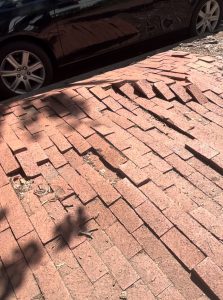Capitol Hill Restoration Society President Angie Schmidt testified on Wednesday, February 5, before the DC Council Committee on Transportation & the Environment, which was holding a performance oversight hearing. Her testimony follows
Performance Oversight Hearing
Committee on Transportation & the Environment
Testimony of Angie Schmidt on behalf of the Capitol Hill Restoration Society – February 5, 2025.
Good morning, Councilmember Allen. My name is Angie Schmidt, and I am testifying as President of the Capitol Hill Restoration Society (CHRS). Since 1955, CHRS, the largest civic organization on Capitol Hill, has advocated for the welfare of the Capitol Hill community. This includes one of the largest residential historic districts in the entire country. We request that DC’s Department of Transportation (DDOT) conduct a pilot project to demonstrate that brick-appearing poured concrete sidewalks could be an aesthetically acceptable, economical and safer alternative to sand-bedded brick.
CHRS is neither pro- nor anti-brick sidewalks. Sidewalks on Capitol Hill have been created out of many different materials over the years. Initially they were installed by individual developers, which created a patchwork block-by-block and even building-by-building. Wood, brick, asphalt, and tile and block were all used over the years. No one style of pavement was adopted by District authorities as the official sidewalk material, and this continues to this day.
In 1983, residents in the historic districts of Georgetown and Capitol Hill pushed for brick as a replacement to enhance the charm of their neighborhoods. City officials made it policy with a published regulation that says the city will replace concrete and asphalt with brick whenever more than 20 feet of walkway in a historic area needs repair. This rule applies to approximately 500 miles of sidewalks across the 14 historic districts in DC.
Brick-in-sand sidewalks need more frequent maintenance than poured-concrete sidewalks, often creating a tripping risk until errant bricks are reset. However these brick sidewalks have become a part of Capitol Hill culture. Therefore we request that DDOT conduct a pilot project to determine if brick-appearing poured concrete sidewalks can work well in Capitol Hill residential neighborhoods – fitting into the DC historic culture and providing fewer tripping hazards.
Under 2019 Sec. 3.3.3 of DDOT Design Standards, Historic Zones – “Materials for Residential and Special Use Zones shall consist of Brick Pavers (red) on sand.” It also states that “Alternative paving material may be approved on a case-by-case basis by DDOT.”
This pilot project sidewalk would be poured concrete colored throughout to the color of brick, and then stamped into a brick pattern. This project, estimated to cost less than $20,000 and already within DDOT’s authority, should involve traditional Capitol Hill community organizations to facilitate the discussion about the results. We recommend that this project be conducted in a DC-owned area with no adjacent houses or businesses. There are many wedge-shaped areas, or pocket parks, located on Capitol Hill which would accommodate this project.
Thank you for considering our testimony.

